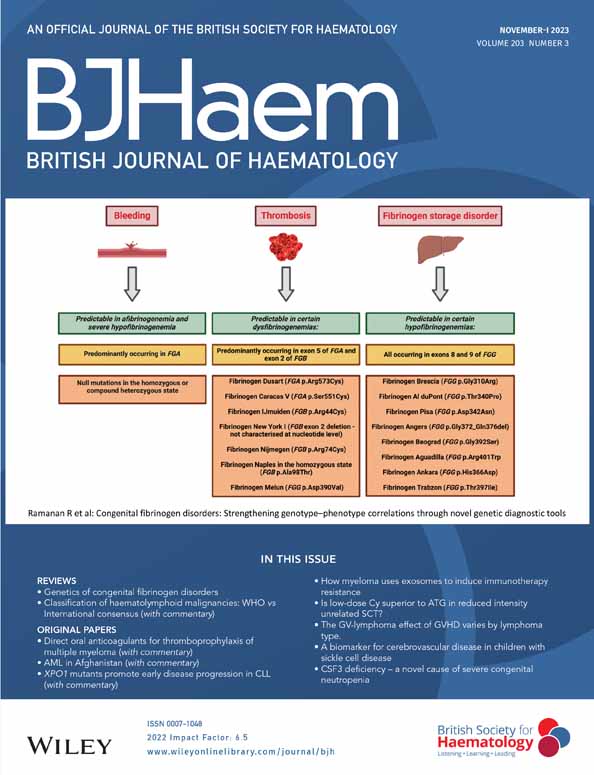Acute myeloid leukaemia in Afghanistan: Understanding an unfamiliar landscape
Abstract
The paper by Noor et al. in this issue provides important and interesting data on the incidence and outcomes of patients with acute myeloid leukaemia in Afghanistan. The age of patients is much lower than we are used to seeing in the West, reflecting in part the particular demographics of the country; these data provide an important first step to identifying areas for improvement.
Commentary on: Noor et al. Demographic and clinical characteristics of acute myeloid leukaemia diagnosed and treated at tertiary level in Afghanistan. Br J Haematol 2023;203:404–410.
Every so often, one is reminded of the danger of becoming set in one's ways. Reading journals, one becomes familiar with the oft-quoted results of the large cooperative groups, particularly those in Europe and the United States. Every group can provide curves similar to those of the UK NCRI group (given recently in this Journal by Burnett et al.1), indicating improved survival for patients treated with curative intent over the last half-century. Quoted results tend to show remission rates in the more recent trials ranging from about 65%–80%, leading to 5 year survival of around 50% in younger adults, with better outcomes in children, and slower but steady progress in older adults treated with intensive chemotherapy. Burnett et al.1 point out that in the United Kingdom, the median age of diagnosis is 68–70.
To someone used to seeing such numbers in print, the data from Noor et al.2 in this issue comes as an important reality check. Remission rates are towards the bottom of the range given above but would not be considered outlandish in a Western population taken as a whole. Yet, the median age of the acute myeloid leukaemia (AML) patients treated at Jumoriat Hospital in Kabul, Afghanistan, is only 27 years. This seems almost incredibly low to Western eyes—but it is important to note the demographic make-up of Afghanistan. The history of war in the region over the past four decades has been extensively covered, and the effects of it and other factors can be seen in the make-up of the population. In contrast to Europe and North America, where the median age is about 40 years with an upper quartile at about age 60, the median age in Afghanistan is only 16 with less than 4% aged 60+.3 With such a small older population, it is not surprising that the median age at diagnosis is lower in Afghanistan than in the West. Indeed, the incidence per 100 000 steadily increases from less than 1% in people below the age of 50 to over 5% in those aged 80 or more, mirroring the effect in the West.
Such data, of course, provides a jumping-off point for a variety of questions. Can the difference in age distribution be solely attributed to difference in population? Or are there other factors at play, such as different diagnostic pathways or willingness to present at secondary or tertiary centres? Or are there other risk factors at work? The last question may be answered by the forthcoming study of the effects of burn pits and pollutants on haematological malignancies announced in July 2023.4
Noor et al. have therefore provided an important service. They remind us that, to those of us who rely too strongly on the data for the UK NCRI trials and other trial groups, which are quoted often in giving headline estimates of incidence and outcomes, Afghanistan is not alone in being, to perpetuate the misquotation of Neville Chamberlain, a far-off country of which we know little.5,* If we are to tackle the global challenge of AML, we must understand it globally and identify ways in which we can improve diagnosis and treatment. Treatment in Afghanistan is with the more traditional agents; without access to the more expensive novel therapeutics, it is important to understand what lessons can be drawn from the past 4–5 decades of treatment with daunorubicin plus cytarabine in terms of the improving outcomes seen in, for example, the UK trials.1 Is it possible to lower the rate of induction death seen in this cohort? However, beyond the salutary lesson for those of us in the West to look beyond our own backyards, Noor et al. take the first steps towards benchmarking outcomes in Afghanistan. With further collaborative research and larger datasets, there can be an investigation of the reasons for the younger incidence, the comparatively higher rates of induction death, and a better delineation of the disease in terms of cytogenetic and molecular characteristics. Long-term outcome data on relapse and mortality will help identify the reasons for failure and target resources to help clinicians in Afghanistan and beyond improve outcomes for patients with AML.
REFERENCES
- * This is a common misquotation. Chamberlain's actual words were a ‘quarrel in a faraway country, between people of whom we know nothing.’




